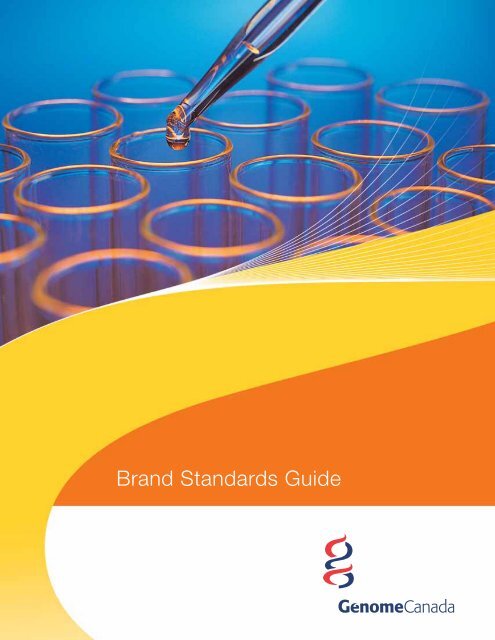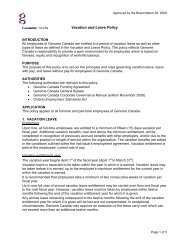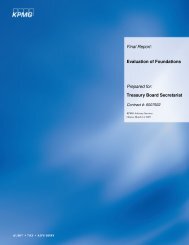Brand Standards Guide - Genome Canada
Brand Standards Guide - Genome Canada
Brand Standards Guide - Genome Canada
Create successful ePaper yourself
Turn your PDF publications into a flip-book with our unique Google optimized e-Paper software.
<strong>Brand</strong> <strong>Standards</strong> <strong>Guide</strong>
IntroductionThis <strong>Brand</strong> <strong>Standards</strong> <strong>Guide</strong> helps designers accuratelyportray <strong>Genome</strong> <strong>Canada</strong>’s personality in external and internalcommunications. The aim is to present a strong, uniform brandmessage to employees of <strong>Genome</strong> <strong>Canada</strong> and <strong>Genome</strong> Centres,as well as to partners and the general public. From writingstyle to colour palette, typography,logos and layout, every element ofa communication should reinforcethe image of <strong>Genome</strong> <strong>Canada</strong> asa science-based organization — aworld leader in providing fundingfor genomics and proteomics research.
The specifications outlined within thisguide will help designers create a strongfamily look for <strong>Genome</strong> <strong>Canada</strong>, yetallow room for individual creativity.While this guide provides generalguidelines, it can’t anticipate every graphicapplication of the <strong>Genome</strong> brand. If youhave a project that requires unspecifiedgraphic treatments, please contact<strong>Genome</strong> <strong>Canada</strong>’s corporate office.
ColoursUsing colour consistently is essential instrengthening brand awareness. Our primarycolours are <strong>Genome</strong> corporate blue and red.Both are used in the <strong>Genome</strong> spiral and logotype.Primary ColoursProcess ColourMonitor ColourPantone ColoursCyan/Magenta/Yellow/BlackRed/Green/BlueC / M / Y / KR / G / BPantone 185 0 / 100 / 100 / 0 255 / 0 / 0Pantone 2758 100 / 80 / 0 / 30 0 / 0 / 102The two primary colours are specified for usein <strong>Genome</strong> <strong>Canada</strong> publications. The coloursshown should be used as main colours incorporate designs.Secondary ColoursProcess ColourMonitor ColourPantone ColoursCyan/Magenta/Yellow/BlackRed/Green/BlueC / M / Y / KR / G / BPantone 418 3 / 0 / 31 / 75 96 / 96 / 77Pantone 158 0 / 61 / 97 / 0 219 / 127 / 49Pantone 123 0 / 24 / 94 / 0 240 / 195 / 59The secondary colour palette may be used forhighlights on other communications campaigns.Here is an example applying secondary colours ona <strong>Genome</strong> <strong>Canada</strong> publication.<strong>Brand</strong> <strong>Standards</strong> <strong>Guide</strong> 3
TypographyThe fonts selected fit into the overall tone anddesign style of the <strong>Genome</strong> <strong>Canada</strong> brand andare intended to make the subject matter moreapproachable. Overall, the fonts exemplify ourcompany’s confidence and contemporary outlook.The headline typeface is Helvetica Neue —distinctive and recognizable.GenomicsProteomicsThe body copy font to be used is Optima —professional and easy-to-read.DistinctiveCONFIDENTContemporaryEX ESEQUISI TEM DIGNA CONSE EUI BLAM DOLENDIT iriustrud dolorperatincilis exercipisis alit luptat ing et atisim vel irit dolessisi blaoreet am, quipit doloreetaugait alit ad tat autpatet alis autatum zzrit nummod tat. Usciduisl enim dip eriuscillafeugait dolorero eu feui tionse dolore vel in ut vent wis autem duis nulla feu feugait.Writing StyleWhen speaking to diverse international audiences,the <strong>Genome</strong> voice is confident, concise anddirect. The writing style should incorporate plainlanguage, with easy-to-understand terminology.Because of the varied audiences, and the complexlanguage of genomics and proteomics, the writingstyle should stress clarity over formality.For communications specifically intended forindividuals, such as career ads, email or otherpersonalized communication, the first and secondperson (“we” and “you”) is to be used. For moreformal communications that reach out to diverseaudiences or the general public, such as factsheets, corporate brochures and media releases,the third person (“<strong>Genome</strong> <strong>Canada</strong>”) shouldbe used.<strong>Brand</strong> <strong>Standards</strong> <strong>Guide</strong> 5
What Not to DoThe following graphic examples indicate what notto do when designing <strong>Genome</strong> <strong>Canada</strong> materials.Always use the master files that have been supplied.Do not change the colour.Do not rotate the logo.Do not recreate the logo.<strong>Canada</strong>Do not distort the logo.Register for our conference todayWe atare...Do not incorporate a tagline in the white space.Do not embed the logo in between text.Do not use the logotype by itself.Do not alter the size relationship of the elements.Do not reverse the logo on a light background.Do not place the logo on a busy background.<strong>Brand</strong> <strong>Standards</strong> <strong>Guide</strong> 6
ApplicationsThe following examples are designs that havealready been produced using various media.<strong>Genome</strong> <strong>Canada</strong> designs rely on the flexibleuse of limited elements to achieve a family look.WebReport CoverPowerPointBrochure<strong>Brand</strong> <strong>Standards</strong> <strong>Guide</strong> 7
Pen case and key chainNewsletterConference pouchContact InformationBefore considering a design that diverges significantlyfrom these precedents, please contact:GENOME CANADAVice-President, Communications and Public Affairsinfo@genomecanada.ca(613) 751-4460www.genomecanada.ca<strong>Brand</strong> <strong>Standards</strong> <strong>Guide</strong> 8








